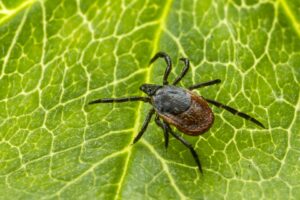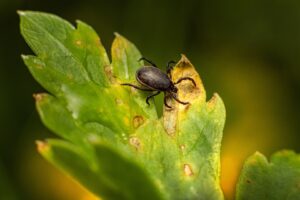Spending time outside—whether hiking, gardening, or walking the dog—is one of the best ways to enjoy Southern California’s sunshine. But as the weather warms, ticks become more active, putting both people and pets at risk for bites and disease. Fortunately, with a few smart tick prevention tips, you can reduce your chances of bringing one of these unwanted hitchhikers home.
Why Tick Prevention Matters
Ticks are more than just a nuisance. Some species can transmit serious illnesses, including Lyme disease, Rocky Mountain spotted fever, and anaplasmosis. Because ticks attach and feed slowly, you may not notice them right away, which gives them time to transmit pathogens. Prevention is the best line of defense.
For more information on how to protect yourself, visit the CDC’s tick prevention page.
How can you recognize a tick?

Female
Adult male ticks are often smaller than adult females. Ticks have a flattened oval or tear dropped shaped body before feeding. Females’ bodies become plump and rounded after gorging on blood.
An easy way to distinguish between male and female ticks, of any species, is to look at the size of the dorsal shield. Regardless of species, the dorsal (upper) shield of males will cover almost the entire abdomen, while the dorsal shield of females will cover only a small portion of the abdomen.
1. Stay on Trails and Avoid Tall Grass
Ticks are ambush hunters. They wait on the tips of grasses, shrubs, and leaf litter, reaching out with their front legs to grab a passing host. To avoid them:

Male
-
Walk in the center of trails when hiking
-
Avoid brushing up against tall grass or vegetation
-
Keep pets on a leash and away from thick underbrush
2. Wear Tick-Repellent Clothing
Clothing choices can play a big role in tick prevention:
-
Wear long sleeves and pants when in tick-prone areas
-
Tuck pants into socks or boots to create a barrier
-
Choose light-colored clothing to make it easier to spot ticks
-
Use permethrin-treated clothing or apply a tick repellent with 20–30% DEET to exposed skin
3. Check Yourself and Your Pets Daily
After spending time outdoors, do a full tick check on yourself, your children, and your pets:
-
Pay close attention to hidden areas: underarms, behind the knees, around the waistline, and in hair
-
Use a fine-toothed comb on pets to check for small ticks
-
Shower within two hours of coming indoors to help remove unattached ticks
4. Keep Your Yard Tick-Safe
Ticks aren’t just a problem in the wilderness—they can show up right in your backyard. Keep your yard less inviting with these steps:
-
Trim back tall grass, weeds, and shrubs
-
Clear leaf litter and debris
-
Stack firewood neatly in dry areas
-
Create a barrier of wood chips or gravel between lawns and wooded areas
-
Keep pets’ outdoor bedding and resting areas away from the edges of the yard
5. Talk to Your Vet About Tick Prevention for Pets
Your dog or cat can easily pick up ticks during outdoor time. Ask your veterinarian about tick prevention options:
-
Oral or topical medications
-
Tick collars
-
Regular inspections, especially after walks or hikes
6. Know When to Call a Professional
If ticks are showing up around your home—or you’re concerned about a possible infestation—it’s best to bring in the pest control professionals at Corky’s. We offer targeted tick control solutions designed to protect your home, pets, and family from these persistent pests.
Give us a call or fill out our contact form to schedule your pest control appointment—we’re here to help you take back your outdoor spaces with confidence.
 800-901-1102
800-901-1102
0 Comments